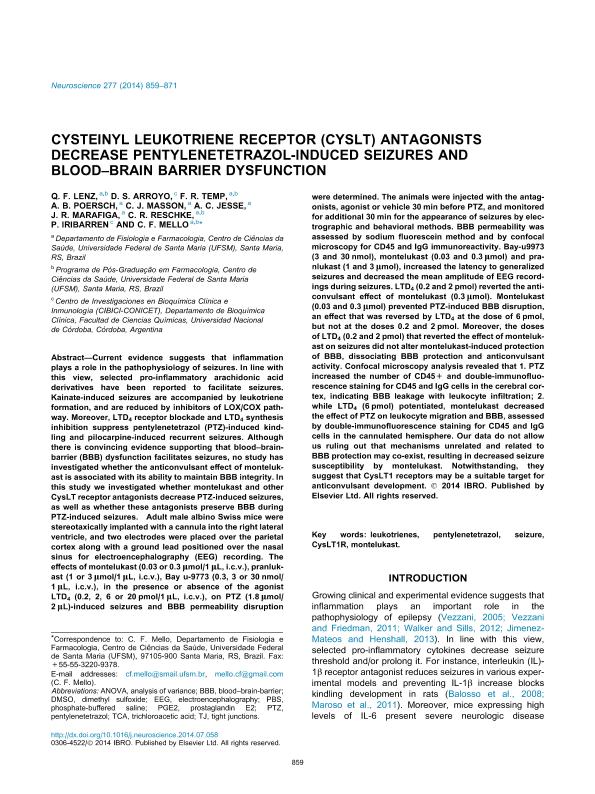Artículo
Cysteinyl leukotriene receptor (CysLT) antagonists decrease pentylenetetrazol-induced seizures and blood–brain barrier dysfunction
Lenz, Q.F.; Arroyo, Daniela Soledad ; Temp, F.R.; Poersch, A.B.; Masson, C.J.; Jesse, A.C.; Marafiga, J.R.; Reschke, C.R.; Iribarren, Pablo
; Temp, F.R.; Poersch, A.B.; Masson, C.J.; Jesse, A.C.; Marafiga, J.R.; Reschke, C.R.; Iribarren, Pablo ; Mello, C.F.
; Mello, C.F.
 ; Temp, F.R.; Poersch, A.B.; Masson, C.J.; Jesse, A.C.; Marafiga, J.R.; Reschke, C.R.; Iribarren, Pablo
; Temp, F.R.; Poersch, A.B.; Masson, C.J.; Jesse, A.C.; Marafiga, J.R.; Reschke, C.R.; Iribarren, Pablo ; Mello, C.F.
; Mello, C.F.
Fecha de publicación:
09/2014
Editorial:
Pergamon-Elsevier Science Ltd.
Revista:
Neuroscience
ISSN:
0306-4522
Idioma:
Inglés
Tipo de recurso:
Artículo publicado
Clasificación temática:
Resumen
Current evidence suggests that inflammation plays a role in the pathophysiology of seizures. In line with this view, selected pro-inflammatory arachidonic acid derivatives have been reported to facilitate seizures. Kainate-induced seizures are accompanied by leukotriene formation, and are reduced by inhibitors of LOX/COX pathway. Moreover, LTD4 receptor blockade and LTD4 synthesis inhibition suppress pentylenetetrazol (PTZ)-induced kindling and pilocarpine-induced recurrent seizures. Although there is convincing evidence supporting that blood–brain-barrier (BBB) dysfunction facilitates seizures, no study has investigated whether the anticonvulsant effect of montelukast is associated with its ability to maintain BBB integrity. In this study we investigated whether montelukast and other CysLT receptor antagonists decrease PTZ-induced seizures, as well as whether these antagonists preserve BBB during PTZ-induced seizures. Adult male albino Swiss mice were stereotaxically implanted with a cannula into the right lateral ventricle, and two electrodes were placed over the parietal cortex along with a ground lead positioned over the nasal sinus for electroencephalography (EEG) recording. The effects of montelukast (0.03 or 0.3 μmol/1 μL, i.c.v.), pranlukast (1 or 3 μmol/1 μL, i.c.v.), Bay u-9773 (0.3, 3 or 30 nmol/1 μL, i.c.v.), in the presence or absence of the agonist LTD4 (0.2, 2, 6 or 20 pmol/1 μL, i.c.v.), on PTZ (1.8 μmol/2 μL)-induced seizures and BBB permeability disruption were determined. The animals were injected with the antagonists, agonist or vehicle 30 min before PTZ, and monitored for additional 30 min for the appearance of seizures by electrographic and behavioral methods. BBB permeability was assessed by sodium fluorescein method and by confocal microscopy for CD45 and IgG immunoreactivity. Bay-u9973 (3 and 30 nmol), montelukast (0.03 and 0.3 μmol) and pranlukast (1 and 3 μmol), increased the latency to generalized seizures and decreased the mean amplitude of EEG recordings during seizures. LTD4 (0.2 and 2 pmol) reverted the anticonvulsant effect of montelukast (0.3 μmol). Montelukast (0.03 and 0.3 μmol) prevented PTZ-induced BBB disruption, an effect that was reversed by LTD4 at the dose of 6 pmol, but not at the doses 0.2 and 2 pmol. Moreover, the doses of LTD4 (0.2 and 2 pmol) that reverted the effect of montelukast on seizures did not alter montelukast-induced protection of BBB, dissociating BBB protection and anticonvulsant activity. Confocal microscopy analysis revealed that 1. PTZ increased the number of CD45+ and double-immunofluorescence staining for CD45 and IgG cells in the cerebral cortex, indicating BBB leakage with leukocyte infiltration; 2. while LTD4 (6 pmol) potentiated, montelukast decreased the effect of PTZ on leukocyte migration and BBB, assessed by double-immunofluorescence staining for CD45 and IgG cells in the cannulated hemisphere. Our data do not allow us ruling out that mechanisms unrelated and related to BBB protection may co-exist, resulting in decreased seizure susceptibility by montelukast. Notwithstanding, they suggest that CysLT1 receptors may be a suitable target for anticonvulsant development.
Palabras clave:
Leukotrienes
,
Pentylenetetrazol
,
Seizure
,
Cyslt1r
,
Montelukast
Archivos asociados
Licencia
Identificadores
Colecciones
Articulos(CIBICI)
Articulos de CENTRO DE INV.EN BIOQUI.CLINICA E INMUNOLOGIA
Articulos de CENTRO DE INV.EN BIOQUI.CLINICA E INMUNOLOGIA
Citación
Mello, C.F.; Iribarren, Pablo; Reschke, C.R.; Marafiga, J.R.; Jesse, A.C.; Masson, C.J.; et al.; Cysteinyl leukotriene receptor (CysLT) antagonists decrease pentylenetetrazol-induced seizures and blood–brain barrier dysfunction; Pergamon-Elsevier Science Ltd.; Neuroscience; 277; 9-2014; 859-871
Compartir
Altmétricas



